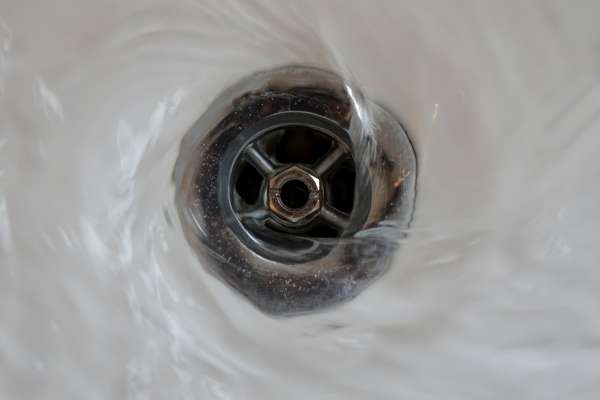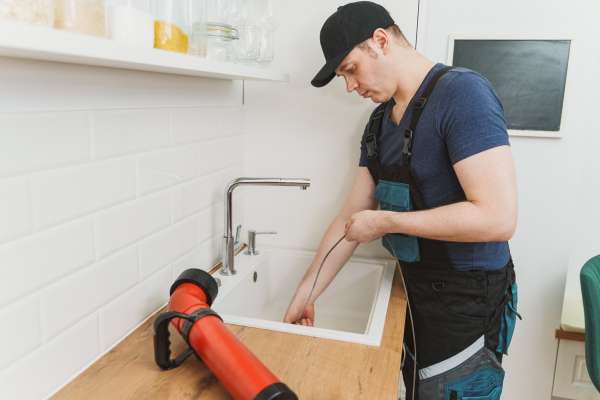The kitchen sink is undeniably one Of the most used And vital components in every household. Over time, With continuous usage, The kitchen sink drain can accumulate grime, grease, And food particles, leading to clogs And unpleasant odors. Ensuring that your kitchen sink drain is clean not only prevents these issues but also maintains A healthier And more sanitary environment in your kitchen. This guide provides you with detailed steps on how to clean your kitchen sink drain effectively and naturally, Without resorting to harsh chemicals, helping You keep your kitchen pristine And odor-free.
Why Clean Kitchen Sink Drain?

Keeping kitchen sink drainage clean is critical for multiple reasons. Firstly, It prevents the buildup of debris and grease that can lead to blockages and inconvenient plumbing issues. Secondly, It eliminates unpleasant odors that may rise from decomposing food particles lodged in the drain. Moreover, Unattended residue in the sink drain can attract pests and provide a breeding ground for bacteria and mold, posing health risks. Regular cleaning can also extend the lifespan Of your plumbing fixtures and reduce the frequency of costly repairs or replacements. Hence, The upkeep of kitchen sink drains significantly contributes to A clean, hygienic, And efficient kitchen environment.
Benefits Of Regular Cleaning

Regular cleaning Of your kitchen sink drainage comes with An array Of benefits.
- Prevents Blockages: Regular cleaning aids in preventing the accumulation Of food debris, grease, And other materials that could cause clogs, leading to A smooth And uninterrupted water flow.
- Eliminates Odor: A clean drain is devoid Of the unpleasant smells that come from the decomposition Of food particles and other materials in the pipes.
- Reduces Bacterial Growth: Regular cleaning inhibits the growth Of bacteria, mold, And mildew, thereby maintaining A healthier environment in the kitchen.
- Avoids Attracting Pests: Clean drains are less likely to attract pests like fruit flies, Which are drawn to food remnants And other organic matter.
- Saves Money: Consistent maintenance Of your sink drainage can prevent severe plumbing problems, Saving you from expensive repairs Or replacements in the future.
- Ensures Durability: Regular cleaning can extend the lifespan Of your sink And drainage system, As it prevents the corrosion Or damage that can be caused by the buildup Of harmful substances.
- Environmentally Friendly: If you clean your drains regularly using natural methods, You can avoid using harsh chemical cleaners that can harm the environment.
Overall, regular gutter cleaning is A simple and cost-effective way Of maintaining the cleanliness And functionality of your kitchen.
What You’ll Need
- Baking Soda
- Vinegar
- Boiling Water
- A Plunger
- A Sink or Drain Snake (optional)
- Rubber Gloves
- Protective Eyewear (optional)
- Old Toothbrush or Small Cleaning Brush
- Lemon or Lemon Juice (optional for extra freshness)
Kitchen Sink Drainage Cleaning Process
Process 1: Flushing The Drain With Water

1. Pour The Hot Water Down The Drainage
Start by boiling A pot of water. Once the water is boiled, carefully pour it directly into the gutter. The hot water will help to loosen And dissolve any grease or soap that may Be causing a blockage. Be sure to pour slowly to avoid splashing hot water.
2. Pour Cold Water Down The Drain
After the hot water, flush the gutter with cold water. You can simply let your faucet run on the coldest setting for about A minute. The cold water will help to solidify any greasy residues that were loosened by the hot water, Making them easier to flush out in the next step.
3. Flush The Drain With Hot Water Again
Repeat the first step by pouring another pot Of boiling water down the drains. This second flush Of hot water should effectively wash away the solidified residues, Leaving your drainage cleaner.
Process 2: Using Baking Soda And White Vinegar

1. Put 1 Cup Of Baking Soda Down The Drain
Begin by measuring out 1 cup of baking soda And carefully pouring it down the gutter. Try to distribute it evenly around the drains hole. Baking soda is excellent for cleaning And deodorizing.
2. Boil 4 Cups Of White Vinegar
Next, you need to heat up 4 cups of white vinegar. While it doesn’t need to boil like water, It should be hot. Vinegar, When combined with baking soda, creates A vigorous fizzing action that can help break up grime and dirt.
3. Pouring The Mixture Down The Drain
Carefully pour the hot vinegar down the drain onto the baking soda. As soon As the vinegar contacts the baking soda, It will start to fizz. This reaction helps to loosen the grime and dirt in the gutter. Leave this mixture in the drain for at least 15 to 30 minutes.
4. Flush With Hot Water
After allowing the baking soda And vinegar to sit and work their magic, Flush the drain with A kettle of boiling water. This will wash away the loosened grime And the cleaning solution, leaving your drainage clean And fresh.
Process 3: Using A Professional Drain Cleaner

Using a professional drain cleaner is one of the more straightforward methods for cleaning A kitchens sink gutter.
Here Are The Steps Involved:
1. Use A Bio-Friendly Drain Cleaner
Bio-friendly Or enzyme-based drain cleaners are An excellent first step, As they can break down organic material (like food particles) that may have built up in your drains. To use, Simply follow the instructions on the cleaner’s packaging, which usually involves pouring a certain amount into the drainage And waiting for the cleaner to do its job. These cleaners are relatively safe And pose little risk to your plumbing or the environment.
2. Apply Chemical Drain Cleaners With Caution
If the bio-friendly cleaner doesn’t do the trick, you may need to resort to a chemical gutter cleaner. However, these should be used as A last resort and with great care due to their corrosive nature. Always read and follow the instructions on the package, And ensure you’re wearing appropriate safety gear (like gloves and eye protection) when handling these cleaners. After applying the cleaner, Let it sit for the recommended time, Then rinse thoroughly with hot water to ensure all the cleaner is removed from your drain. Remember, frequent use Of chemical drain cleaners can damage your pipes, So consider contacting A professional if the drain remains clogged after using one.
Process 4: Mechanical Cleaning Methods

Mechanical methods Are also effective in clearing stubborn blockages in your kitchens sink drainage.
Here Are Two CommonlyUsed Mechanical Methods:
1. Plunger
The classic plunger can be A useful tool for dislodging clogs in your kitchen sinks. To use A plunger, first, ensure there’s enough water in the sink to cover the plunger base. Then, firmly place the plunger over the drainage and push down, Then pull up quickly to create suction. Repeat this action several times until you notice the water starting to drains. If it’s A minor clog, The plunger might Be all you need.
2. Plumbing Snake Or Drain Auger
If the clog persists after using A plunger, A plumbing snake or drains auger can be used. This tool is A flexible coil of wire that can reach deep into your plumbing to break up or retrieve the clog. To use A drain auger, You’ll insert it into the gutter And then turn the handle to extend it further into the plumbing. As you push the snake down, It will either break up the clog or latch onto it, Allowing you to pull it out. Be sure to handle this tool with care as improper use can damage your pipes. If you’re uncomfortable using A Importance Of Regular maintenance Of your kitchens sink drain is vital for A variety of reasons.
Firstly, It can prevent build-ups and clogs. Regularly cleaning your sink drainage can prevent the accumulation of food particles, grease, And other debris that can lead to severe blockages. A clogged drainage can Be disruptive, causing backups And potentially leading to more significant issues, such As pipe leaks Or even bursts if the pressure becomes too much.
Secondly, It can eliminate unpleasant odors. Over time, organic matter trapped in the gutter can start to decompose, Which can produce A foul smell. Regular cleaning can help to remove these materials And keep your kitchen smelling fresh.
Moreover, It can extend the lifespan of your plumbing system. Keeping your pipes clean and clear can help them last longer, Saving you from costly replacements or repairs. Consistent maintenance can also help you spot potential problems early before they escalate into more significant issues.
Lastly, It can contribute to A healthy and hygienic kitchen environment. A clean gutter reduces the risk of bacteria and mold growth, Which could otherwise pose A risk to your household’s health.
Therefore, It’s clear that regular maintenance Of your kitchens sink drainage is A necessary task that contributes significantly to the smooth operation Of your kitchen and the overall health And wellbeing of your household.
The Final Thoughts
Cleaning the kitchen sink drainage is An essential task to maintain A healthy and hygienic kitchen environment. A clogged Or dirty drain can lead to unpleasant odors, Slow drainage, And even potential plumbing issues. By following a few simple steps, You can effectively clean your kitchen sink drain and ensure its optimal functionality. Start by removing any visible debris Or food particles from the drain, Then use A mixture of baking soda And vinegar to break down grease And eliminate odors. Additionally, regular maintenance such as using a drain strainer and flushing the drain with hot water can help prevent future clogs. Remember to exercise caution when using any chemicals or tools, And if the problem persists, it may be necessary to seek professional assistance. By keeping your kitchen sink drain clean and well-maintained, You can promote a clean and healthy kitchen environment for you and your family.
